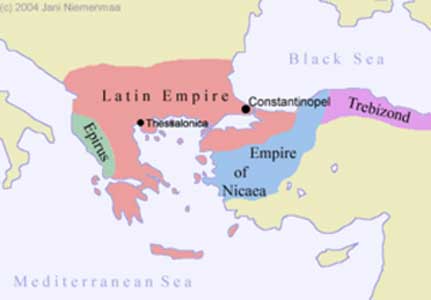Empire of Nicaea
The Empire of Nicaea was the largest of the states founded by refugees from the Byzantine Empire after Constantinople was conquered during the Fourth Crusade. It lasted from 1204 to 1261.
Foundation

The Latin Empire, Empire of Nicaea, Empire of Trebizond and the Despotate of Epirus. The borders are very uncertain.
In 1204, Byzantine emperor Alexius V fled Constantinople rather than face the crusader army in battle. Theodore Lascaris, the son-in-law of Emperor Alexius III, was proclaimed emperor, but he too fled, to the city of Nicaea in Bithynia, realizing the situation in Constantinople was hopeless.
The Latin Empire which was established by the crusaders in Constantinople had poor control over former Byzantine territory, and Byzantine successor states sprang up in Epirus and Trebizond as well as Nicaea. Nicaea, however, was the closest to the Latin Empire and was in the best position to attempt to re-establish the Byzantine Empire. Theodore Lascaris was not immediately successful, as he was defeated at Poemanenum and Bursa in 1204, but he was able to capture much of northwestern Anatolia after the Latin Emperor Baldwin I had to defend against invasions from Kaloyan of Bulgaria. Theodore also defeated an army from Trebizond, as well as other minor rivals, leaving him in charge of the most powerful of the successor states. In 1206 Theodore proclaimed himself emperor at Nicaea.
Numerous truces and alliances were formed and broken over the next few years, as the Byzantine successor states, the Latin Empire, the Bulgarians, and the Seljuks of Iconium (whose territory also bordered Nicaea) fought each other. Theodore tried to validate his claim by naming a new Patriarch of Constantinople in Nicaea. In 1219 he married the daughter of Latin Empress Yolanda of Flanders, but he died in 1222 and was succeeded by his son-in-law John III Ducas Vatatzes.
Expansion
In 1224 the Latin Kingdom of Thessalonica was captured by the Despot of Epirus, but Epirus itself came under Bulgarian control in 1230. With Trebizond lacking any real power, Nicaea was the only Byzantine state left, and John III expanded his territory into the Aegean Sea. In 1235 he allied with Ivan II of Bulgaria, allowing him to extend his influence over Thessalonica and Epirus. In 1242 the Mongols invaded Seljuk territory to the west of Nicaea, and although John III was worried they may attack him next, they ended up eliminating the Seljuk threat to Nicaea. In 1245 John allied with the Holy Roman Empire by marrying Constance Anna, daughter of Frederick II. By 1248 John had defeated the Bulgarians and surrounded the Latin Empire. He continued to take land from the Latins until his death in 1254.
Theodore II Lascaris, John III’s son, faced invasions from the Bulgarians in Thrace, but successfully defended the territory. Epirus also revolted and allied with Manfred of Sicily, and Theodore II died in 1258. John IV Lascaris succeeded him, but as he was still a child he was under the regency of the general Michael Palaeologus. Michael proclaimed himself co-emperor (as Michael VIII) in 1259, and soon defeated a combined invasion by Manfred, the Despot of Epirus, and the Latin Prince of Achaea at the Battle of Pelagonia.
Recapture of Constantinople
Coin issued by Michael VIII Palaeologus to celebrate the liberation of Costantinople from the Latin army, and the restoration of the Byzantine Empire.
In 1260 Michael began the assault on Constantinople itself, which his predecessors had been unable to do. He allied with Genoa, and his general Alexios Strategopoulos spent months observing Constantinople in order to plan his attack. In July of 1261, as most of the Latin army was fighting elsewhere, Alexius was able to convince the guards to open the gates of the city. Once inside he burned the Venetian quarter (as Venice was an enemy of Genoa, and had been largely responsible for the capture of the city in 1204). Michael was recognized as emperor a few weeks later, restoring the Byzantine Empire.
The inhabitants of the restored empire considered the Empire of Nicaea the true successor to the Byzantine Empire, although the Empire of Trebizond still existed, as did the Latin Principality of Achaea. Achaea was soon recaptured, but Trebizond remained independent. The restored empire also faced a new threat from the Ottoman Empire, when it arose to replace the defeated Seljuks.
Emperors of Nicaea
- Theodore I Lascaris (1204-1222)
- John III Ducas Vatatzes (1222-1254)
- Theodore II Lascaris (1254-1258)
- John IV Lascaris (1258-1261)
- Michael VIII Palaeologus (co-emperor 1259-1261; restored Byzantine Empire)
Jonathan Phillips, The Fourth Crusade and the Sack of Constantinople, Pimlico, 2005. ISBN 1844130800
John Julius Norwich, A Short History of Byzantium ,Vintage; Reprint edition 1998, ISBN: 0679772693
| Ancient Greece
Science, Technology , Medicine , Warfare, , Biographies , Life , Cities/Places/Maps , Arts , Literature , Philosophy ,Olympics, Mythology , History , Images Medieval Greece / Byzantine Empire Science, Technology, Arts, , Warfare , Literature, Biographies, Icons, History Modern Greece Cities, Islands, Regions, Fauna/Flora ,Biographies , History , Warfare, Science/Technology, Literature, Music , Arts , Film/Actors , Sport , Fashion --- |
Retrieved from "http://en.wikipedia.org"
All text is available under the terms of the GNU Free Documentation License

